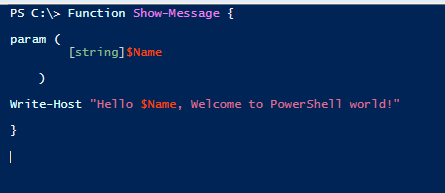Unlock the Power of PowerShell Functions to Simplify Your Daily IT Tasks
- Vicky Kadam

- Jul 26
- 4 min read
Updated: Jul 31
Are you overwhelmed by repetitive IT tasks? PowerShell can significantly ease your burden. It is a versatile scripting language designed for task automation within the Windows ecosystem. One of its standout features is Functions—blocks of reusable code. By using functions, you can simplify daily operations and make your workflow much more efficient.
In this post, we will explore the world of PowerShell Functions. We will cover their structure, significance, and practical applications, providing you with examples and actionable tips to unlock their full potential.
What are PowerShell Functions?
At its core, a Function in PowerShell is a named block of code that executes when called. Functions not only help you group related commands, but they also enhance the readability and reusability of your scripts. This can lead to a drastic reduction in the amount of code you write.
Functions can also accept parameters, which allow you to customize their behavior. Furthermore, they can return values, enabling data to flow back to the calling context.
Here's a simple syntax to define a function in PowerShell:
```powershell
function FunctionName {
# Your code here
}
```
Let’s take a closer look.
Defining a Function
Creating a function in PowerShell is straightforward:
Start with the `function` keyword, followed by a unique name.
Open a curly brace `{`, add the commands you want to execute, and close with `}`.
For example, to display a greeting message, your function would look like this:
```powershell
function Show-Message {
Write-Host "Hello, PowerShell!"
}

You can run this function by simply typing `Show-Message` in the command line. It's that easy!
Why Use Functions?
Functions bring multiple benefits to your PowerShell scripting:
Code Reusability: Rather than rewriting the same set of commands, a function allows you to call it whenever you need it. This could save you hours, especially if you have to check disk usage on multiple servers.
Improved Organization: Functions break down larger, complex scripts into smaller parts. This makes your scripts easier to read and maintain.
Parameterization: Functions that accept input parameters can be used in various situations. For instance, you can create a user management function that takes usernames as input.
Increased Efficiency: A well-structured function reduces errors and streamlines updates. For example, if a process changes, you can update it in one location instead of multiple scripts.
Let’s delve into some practical examples of PowerShell functions designed to ease your daily IT tasks.
Example 1: Disk Usage Report Function
Checking disk usage across multiple servers is a common task. Instead of running multiple commands, create a function to generate a report.
```powershell
function Get-DiskUsage {
Get-PSDrive -PSProvider FileSystem | Select-Object Name, @{ Name="Used(GB)"; Expression={[math]::round($_.Used/1GB,2)}}, @{ Name="Free(GB)"; Expression={[math]::round($_.Free/1GB,2)}}, @{ Name="Total(GB)"; Expression={[math]::round(($_.Used + $_.Free)/1GB,2)}}
}
```
When you execute `Get-DiskUsage`, it provides an easy-to-read report of disk usage across all drives, showing used, free, and total space in gigabytes.
Example 2: User Account Management Function
Managing user accounts can be cumbersome, especially in larger organizations. Simplify this with a function to create new user accounts:
```powershell
function New-User {
param (
[string]$UserName,
[string]$Password
)
New-LocalUser -Name $UserName -Password (ConvertTo-SecureString $Password -AsPlainText -Force) -Fullname "$UserName User"
}
```
With this, you can create a new user by calling `New-User -UserName "john.doe" -Password "YourPassword123!"`. This method saves you time and ensures consistency when managing accounts.
Example 3: Scheduled Task Function
Creating scheduled tasks can be tedious. Simplify the process with this function:
```powershell
function New-ScheduledTask {
param (
[string]$TaskName,
[string]$ScriptPath
)
$action = New-ScheduledTaskAction -Execute $ScriptPath
$trigger = New-ScheduledTaskTrigger -AtStartup
Register-ScheduledTask -Action $action -Trigger $trigger -TaskName $TaskName
}
```
You can easily set up a new scheduled task by calling `New-ScheduledTask -TaskName "MyTask" -ScriptPath "C:\Scripts\MyScript.ps1"`.
Example 4: System Update Function
Keeping your systems up to date is essential for both security and performance. Here's a simple function to check for and install Windows Updates:
```powershell
function Update-System {
Write-Host "Checking for updates..."
Install-WindowsUpdate -AcceptAll -AutoReboot
}
```
When you run `Update-System`, it checks for available updates and installs them, helping maintain system integrity.
Maximizing the Benefits of Functions
To maximize the value from your functions, keep these best practices in mind:
Descriptive Naming: Use clear, descriptive names for your functions. This helps you and others understand their purpose without diving deep into the code.
Parameter Validation: Utilize parameter validation to ensure that only acceptable data types are passed. This can reduce errors and improve function reliability.
Documentation: Comment within your function to explain what it does and its parameters. This practice will assist you in the future when you revisit your code.
Error Handling: Incorporate error handling techniques using `try-catch` blocks. This can guide users when something goes wrong, leading to faster troubleshooting.
Thorough Testing: Always test functions in a safe environment to confirm they work as expected before applying them elsewhere.
Final Thoughts
PowerShell Functions are transformative for IT professionals. They allow you to automate repetitive tasks, improve script organization, and boost overall productivity. By leveraging the capabilities of functions, you can simplify your operations and free up valuable time to focus on higher-priority tasks.
Don't let the complexity of daily IT responsibilities overwhelm you; embrace the power of PowerShell Functions! Start by implementing the examples in this post and tailor your functions to meet your organization's specific needs. This strategy will not only lighten your workload but also empower you to become a more effective IT professional.
Unlock the full potential of PowerShell Functions today and elevate your IT processes!

Comments